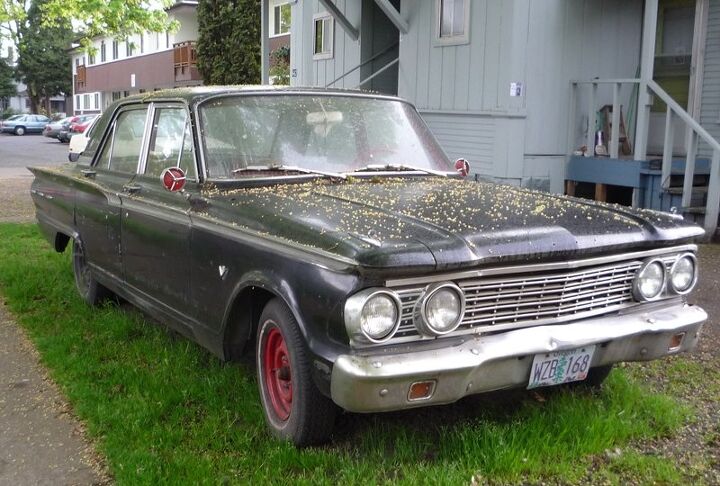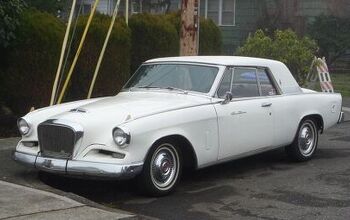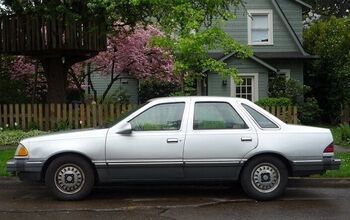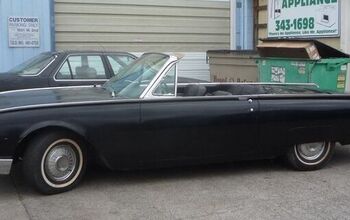Curbside Classic: 1962 Ford Fairlane

They say you can’t go home again. True enough, but as you read this, Edward and the rest of my family and I will be winging our way to Baltimore for a long overdue family reunion. My father recently turned ninety, and my mother will be eighty-seven soon. So what is the obvious choice of today’s Curbside Classic? The Niedermeyer family car from the early sixties, a black 1962 Fairlane, and in every way exactly like this one, except that ours was the base stripper, not the deluxe 500 like this one. That alone tells you something about the old man.
If you want to properly place this Fairlane in the Niedermeyer family history, here’s the corresponding chapter of the Autobiography. Or the Cliff Notes version: We emigrated from Austria in 1960 to Iowa City, Iowa, my father having been recruited to the University of Iowa, and bought a used 1954 Ford Mainline sedan upon our arrival. Six year old cars back then were already geriatric; my five year old xB is barely a teenager in comparison. The ’54 Ford blue whale was roomy for a family of six, and did the job, mostly, except for not wanting to break its slumber on cold winter mornings. But it was feeling its age, so one day in the winter of 1962, my father unexpectedly showed up with this black Fairlane, bare bones except for the brand new 221 CID V8 and the Ford-O-Matic. I had very mixed emotions.
Yes, it was a new car, not just factory fresh, but the ’62 Fairlane was a totally new creature from Detroit: the first intermediate-sized car from the Big Three. Sure, Ramblers of the times were essentially mid-sized cars, and perhaps the Studebaker Lark should best be considered one too. And it was the remarkable success of the Ramblers that undoubtedly inspired Ford to take the lead with the new Fairlane.
Keep in mind, this was just two years after Ford’s smash success with the Falcon. And just as the Falcon was the basis for the Mustang in 1964, so it also sired the Fairlane. In fact, it would be fair to say that the Fairlane was just a stretched Falcon, the kind of thing done routinely nowadays. And just to confuse matters even more, the Mercury Comet slotted in between the two in length, although it used the narrower width Falcon body. That kept me scratching my head back then. Ford was ahead of the times, and if you wonder where Lee Iacocca got his inspiration for endless variations and different lengths for all the Chrysler K-cars, here it is. History inevitably repeats itself.
So why wasn’t I as excited as I could/should have been as a nine year old car fanatic when Dad shows up with the first brand new car ever? Let me count the ways, starting with the neighbors across the street. They had a matching brace of 1960 Bonnevilles; a hardtop sedan for him, and the wagon for her. I obsessed on them, and had my heart set on the 1962 versions for the Niedermeyer livery. The fact that the car-nut in the family wasn’t even consulted alone was hard to take, but that pattern was to repeat itself endlessly, except for two notable exceptions.
Given the fact that we weren’t exactly a touchy-feely sort of family, I definitely had my eye on a wagon with a third seat for a little elbow room. In 1962, my sister was fourteen, my older brother twelve, and my younger brother three. The painful reality is that the Fairlane is roughly about the size of today’s Civic or Corolla. Extended skin contact with siblings was not my idea of how to spend two days straight on our vacation trips to Colorado. And before I forget, nobody ever rode in the front middle; we had to do skin contact; he didn’t.
Our Fairlane was utterly stripped of any excess ornamentation, worthy of taxi-cab service. But in my father’s eye, the cheap seat upholstery was something to be well preserved, so he ordered a set of clear plastic seat covers from Fingerhut, the perfectly smooth ones, not the more expensive ones with raised bumps on them to create channels to drain the rivulets of sweat away. No, that would have been extravagant. We literally had to peel ourselves off those seats in the summer, given the short shorts of the era.
It gets worse. My dear father always had a severe issue with drafts, especially around his neck. And he’s always cold; rarely will you see him without a cardigan (or two), even in the summer. So only the front windows were allowed to be opened a tiny crack, even on the hottest summer days. Air conditioning? What’s that? So that’s how we spent two days each way driving to Colorado every summer, and on other trips. But it gets worse yet! In 1964, we were all two years older and much bigger, and my mother was seven months pregnant, and we all crammed in for a three day torture session to the New York World’s Fair, and then back again. If a child was forced today to endure what we did on that trip, jammed into that hot black Fairlane, and the resulting expressions of emotions it engendered, the Child Protective Services would have cut that trip well short, somewhere in Ohio, I’d say. Father, somehow I still love you, despite the miserable cramped black Fairlane you tortured us/yourself with. Didn’t you know you could buy a full-sized wagon for just a few hundred dollars more?
He finally (almost) tumbled to that in 1965, when the Fairlane was traded in on a 1965 Dodge Coronet eight-seat wagon; technically still a mid-sized, but a huge improvement. Since it coincided with my sister’s departure from the family fold, skin contact issues took a huge step forward. Kids today have no idea what we endured back then. And kids in the Depression would undoubtedly have thought us to be spoiled babies. And so on…
Enough Niedermeyer family carma. The Fairlane wasn’t quite the success that the Falcon was. But then that was a monster, selling almost a half million in its first year. Nevertheless, it was another coup for Ford in its ability to expand at the expense of GM in the early-mid sixties, by expanding into niches that hadn’t been exploited fully yet. And undoubtedly, the Fairlane was developed and built on the cheap, given its Falcon bones. The only noteworthy thing about it was it was the first car to use Ford’s brand new small-block Windsor V8. Why the hell Ford chose to build it in a 221 cubic inch version, with a modest 145 (gross) hp is hard to fathom. By mid-year, the larger 260 CID version already debuted along with the bucket-seated 500 coupe. And a year and a half later, the definitive 289 replaced them all. Ford like to keep the boring machines guessing.
The little 221 was a smooth and tidy mill, but it was no more powerful than the Chevy 230 or the Chrysler 225 slant sixes, and because it had eight cylinders, it intrinsically had a less favorable torque curve. After 1963, the 221 inch V8 was gone; an oddity of Ford history. But the fact that our stripper Fairlane at least had the little V8 was its redeeming grace. That badge on the front fender meant more to my self esteem during that difficult period in my life than my father will ever know. I might not be who I am today because of it. Thanks, Dad!
My sister used to come to pick me up from grade school every Wednesday to drive me and a friend to the all-city orchestra rehearsal. On the one slightly longer stretch of road near the school we would goad her to floor it. She obliged, but we had to floor and kick-down our imaginations to experience some sort of true and visceral accelerative experience. With the two-speed Ford-O-Matic (technically it was a three speed, but one had to engage Low manually, which sis was not doing) the little V8 whispered rather than bellowed its efforts to accelerate the fairly light 2800 lb sedan.
This particular forlorn Fairlane sits in front of an old house near downtown, owned by a couple of young sisters who live in the upstairs apartment. I know this because it has a For Sale sign on it now, and I talked to the guy who lives below them. He’s tired of looking at it, and told me that they would probably take anything for it, since the next stop is the junk yard if no one steps up. He encouraged me, eager to rid himself of the eyesore. I though about it briefly, but then I remembered the words: you can’t go home again. And even if I could, I’m not so sure I’d want to.

More by Paul Niedermeyer
Latest Car Reviews
Read moreLatest Product Reviews
Read moreRecent Comments
- Peter Buying an EV from Toyota is like buying a Bible from Donald Trump. Don’t be surprised if some very important parts are left out.
- Sheila I have a 2016 Kia Sorento that just threw a rod out of the engine case. Filed a claim for new engine and was denied…..due to a loop hole that was included in the Class Action Engine Settlement so Hyundai and Kia would be able to deny a large percentage of cars with prematurely failed engines. It’s called the KSDS Improvement Campaign. Ever hear of such a thing? It’s not even a Recall, although they know these engines are very dangerous. As unknowing consumers load themselves and kids in them everyday. Are their any new Class Action Lawsuits that anyone knows of?
- Alan Well, it will take 30 years to fix Nissan up after the Renault Alliance reduced Nissan to a paltry mess.I think Nissan will eventually improve.
- Alan This will be overpriced for what it offers.I think the "Western" auto manufacturers rip off the consumer with the Thai and Chinese made vehicles.A Chinese made Model 3 in Australia is over $70k AUD(for 1995 $45k USD) which is far more expensive than a similar Chinesium EV of equal or better quality and loaded with goodies.Chinese pickups are $20k to $30k cheaper than Thai built pickups from Ford and the Japanese brands. Who's ripping who off?
- Alan Years ago Jack Baruth held a "competition" for a piece from the B&B on the oddest pickup story (or something like that). I think 5 people were awarded the prizes.I never received mine, something about being in Australia. If TTAC is global how do you offer prizes to those overseas or are we omitted on the sly from competing?In the end I lost significant respect for Baruth.



























![Curbside Classic: 1962 Corvette – The Marilyn Monroe Of Cars [NSFW Alert]](https://cdn-fastly.thetruthaboutcars.com/media/2022/07/20/9479696/curbside-classic-1962-corvette-the-marilyn-monroe-of-cars-nsfw-alert.jpg?size=350x220)














Comments
Join the conversation
My first car at 17 was an eight year old 1963 2 door coupe. It had the 200c.i. six w/ a 2-speed auto. I painted the car, slapped on a cherry bomb muffler, air shocks, wide tires & chrome reverse rims. Loved that thing, and that started a lifetime love affair with cars, for better or worse, ha!
I have read that McNamara was planning on discontinuing the big Ford after 1961. I guess the plan was for the 1962 Fairlane to be the flagship model. I wonder if it had happened that way, if the top of the line Fairlane would have been called "Galaxie 500" since the big cars were gone. I also read that McNamara wanted to cancel V8 engines. Which would have been foolish, to say the least, because Ford made its reputation on the V8. Good thing Kennedy came along and saved Ford from this dipshit and his boneheaded decisions. Ford would no longer be with us if the big Galaxie had gone away after 1961. Ford might be toast now because of its recent idiotic decision to quit making cars other than the Mustang. As soon as gas prices skyrocket, those crossovers and trucks will sit on dealer lots until they rust away.